 W
WIn baseball, a pitcher can commit a number of illegal motions or actions that constitute a balk. Most of these violations involve a pitcher pretending to pitch when he has no intention of doing so. In games played under the Official Baseball Rules that govern professional play in the United States and Canada, a balk results in a dead ball or delayed dead ball. In certain other circumstances, a balk may be wholly or partially disregarded. Under other rule sets, notably in the United States under the National Federation of High Schools Baseball Rules, a balk results in an immediate dead ball. In the event a balk is enforced, the pitch is generally nullified, each runner is awarded one base, and the batter (generally) remains at bat, and with the previous count. The balk rule in Major League Baseball was introduced in 1898.
 W
WA base on balls (BB), also known as a walk, occurs in baseball when a batter receives four pitches that the umpire calls balls, and is in turn awarded first base without the possibility of being called out. The base on balls is defined in Section 2.00 of baseball's Official Rules, and further detail is given in 6.08(a). It is considered a faux pas for a professional player to literally walk to first base; the batter-runner and any advancing runners normally jog on such a play.
 W
WThe Black Aces are a group of black pitchers who have won at least 20 Major League Baseball games in a single season. The term comes from the title of a book written by former Major League Baseball (MLB) pitcher Mudcat Grant, one of the members of the group.
 W
WIn baseball, a closing pitcher, more frequently referred to as a closer, is a relief pitcher who specializes in getting the final outs in a close game when his team is leading. The role is often assigned to a team's best reliever. Before the 1990s, pitchers in similar roles were referred to as a fireman, short reliever, and stopper. A small number of closers have won the Cy Young Award. Eight closers have been inducted into the Baseball Hall of Fame: Dennis Eckersley, Rollie Fingers, Goose Gossage, Trevor Hoffman, Mariano Rivera, Lee Smith, Bruce Sutter and Hoyt Wilhelm.
 W
WThe Cy Young Award is given annually to the best pitchers in Major League Baseball (MLB), one each for the American League (AL) and National League (NL). The award was first introduced in 1956 by Baseball Commissioner Ford Frick in honor of Hall of Fame pitcher Cy Young, who died in 1955. The award was originally given to the single best pitcher in the major leagues, but in 1967, after the retirement of Frick, the award was given to one pitcher in each league.
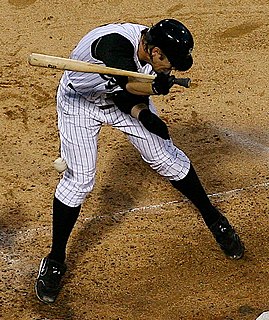 W
WIn baseball, hit by pitch (HBP) is an event in which a batter or his clothing or equipment is struck directly by a pitch from the pitcher; the batter is called a hit batsman (HB). A hit batsman is awarded first base, provided that he made an honest effort to avoid the pitch, although failure to do so is rarely called by an umpire. Being hit by a pitch is often caused by a batter standing too close to, or "crowding", home plate.
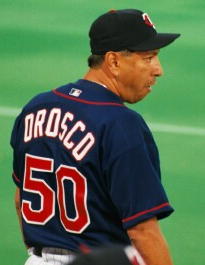 W
WIn baseball, a left-handed specialist is a relief pitcher who throws left-handed and specializes in pitching to left-handed batters, weak right-handed batters, and switch-hitters who bat poorly right-handed. Because baseball practices permanent substitution, these pitchers frequently pitch to a very small number of batters in any given game, and rarely pitch to strictly right-handed batters. Most Major League Baseball (MLB) teams have several left-handed pitchers on their rosters, at least one of whom is a left-handed specialist. A left-handed specialist is sometimes called a LOOGY, coined by John Sickels, and may be used pejoratively.
 W
WLittle League elbow is a condition that is caused by repetitive throwing motions, especially in children who play sports that involve an overhand throw. "Little Leaguer's elbow" was coined by Brogdon and Crow in an eponymous 1960 article in the American Journal of Radiology.
 W
WIn baseball, a no-hitter is a game in which a team was not able to record a single hit through conventional means. Major League Baseball (MLB) officially defines a no-hitter as a completed game in which a team that batted in at least nine innings recorded no hits. A pitcher who prevents the opposing team from achieving a hit is said to have "thrown a no-hitter". This is a rare accomplishment for a pitcher or pitching staff—only 305 have been thrown in MLB history since 1876, an average of about two per year. In most cases, no-hitters are recorded by a single pitcher who throws a complete game; one thrown by two or more pitchers is a combined no-hitter. The most recent major league no-hitter by a single pitcher was thrown on September 13, 2020, by Alec Mills of the Chicago Cubs against the Milwaukee Brewers at Miller Park. The most recent combined no-hitter was thrown on August 3, 2019, by Aaron Sanchez, Will Harris, Joe Biagini, and Chris Devenski of the Houston Astros against the Seattle Mariners at Minute Maid Park.
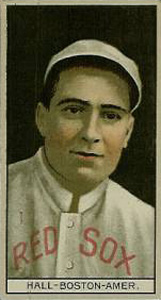 W
WThe American Association (AA) was a Minor League Baseball league that operated primarily in the Midwestern and South Central United States from 1902 to 1962 and 1969 to 1997. Over a 90-year span, pitchers on its teams pitched 95 no-hitters, which include 5 perfect games. Of these no-hitters, 72 were pitched in games that lasted at least the full nine innings, while 23 were pitched in games shortened due to weather or that were played in doubleheaders. Only three of the league's five perfect games were tossed in full nine-inning games. Five no-hitters were combined—thrown by two or more pitchers on the same team.
 W
WIn the 118-year history of the Pacific Coast League (PCL), its pitchers pitched 167 no-hitters, which include 10 perfect games. Of these no-hitters, 102 were pitched in games that lasted at least the full nine innings, while 65 were pitched in games shortened due to weather or that were played in doubleheaders. Only three of the league's ten perfect games were tossed in full nine-inning games. Nine no-hitters, including one perfect game, were combined—thrown by two or more pitchers on the same team.
 W
WIn baseball, an opening pitcher, more frequently referred to as an opener, is a pitcher who specializes in getting the first outs in a game, before being replaced by a long reliever or a pitcher who would typically be a starting pitcher. Pitchers employed in the role of opener have usually been relief pitchers by trade. The strategy was frequently employed in Major League Baseball (MLB) by the Tampa Bay Rays during the 2018 season, when it was adopted by other teams as well.
 W
WOver the 150 years of Major League Baseball history, and over 218,400 games played, there have been 23 official perfect games by the current definition. No pitcher has ever thrown more than one. The perfect game thrown by Don Larsen in game 5 of the 1956 World Series is the only postseason perfect game in major league history and one of only two postseason no-hitters. The first two major league perfect games, and the only two of the premodern era, were thrown in 1880, five days apart. The most recent perfect game was thrown on August 15, 2012, by Félix Hernández of the Seattle Mariners. The frequency of perfect games has increased significantly since 1981. Fourteen perfect games were thrown in the 40 seasons from 1980 through 2019, while only nine were thrown in the 100-plus prior seasons. There were three perfect games in 2012; the only other year of the modern era in which as many as two were thrown was 2010. By contrast, there have been spans of 23 and 33 consecutive seasons in which no perfect game was thrown. Though two perfect-game bids have gone into extra innings, no extra-inning game has ever been completed to perfection.
 W
WIn baseball, the pitcher is the player who throws the baseball from the pitcher's mound toward the catcher to begin each play, with the goal of retiring a batter, who attempts to either make contact with the pitched ball or draw a walk. In the numbering system used to record defensive plays, the pitcher is assigned the number 1. The pitcher is often considered the most important player on the defensive side of the game, and as such is situated at the right end of the defensive spectrum. There are many different types of pitchers, such as the starting pitcher, relief pitcher, middle reliever, lefty specialist, setup man, and the closer.
 W
WA pitching machine is a machine that automatically pitches a baseball to a batter at different speeds and styles. Most machines are hand-fed, but there are some that automatically feed. There are multiple types of pitching machines; softball, baseball, youth, adult, and a combination of both softball and baseball.
 W
WIn baseball or softball, a pitchout is a ball that is intentionally thrown high and outside the strike zone with the purpose of preventing a stolen base, thwarting a hit and run, or to prevent a run-scoring play on a suicide squeeze play. The pitcher delivers the ball in such a manner for it to be unhittable and in a position where the catcher can quickly leap to their feet to catch it. A well-thrown pitchout will allow the catcher to receive the ball standing up as opposed to their usual squat, giving them a better line to throw to a base without the pitcher or the batter obstructing their vision or aim. Moreover, it is easier to throw a ball with more force from a standing position than it is from a squat, which is why most catchers leap to their feet when attempting to throw out a base stealer. A pitchout is a type of intentional ball, but differs in that a pitchout is thrown harder to give the catcher the most time to throw out the base runner.
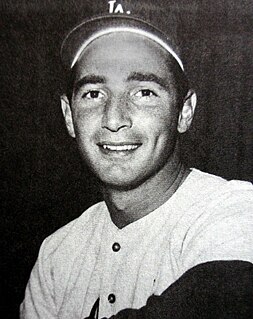 W
WPower pitcher is a term in baseball for a pitcher who relies on pitch velocity at the expense of accuracy. Power pitchers usually record a high number of strikeouts, and statistics such as strikeouts per 9 innings pitched are common measures of power. An average pitcher strikes out about 5 batters per nine innings while a power pitcher will often strike out one or more every inning. The prototypical power pitcher is National Baseball Hall of Fame member, Nolan Ryan, who struck out a Major League Baseball record 5,714 batters in 5,386 innings. Ryan recorded seven no-hitters, appeared in eight Major League Baseball All-Star Games but also holds the record for most walks issued (2,795).
 W
WIn baseball and softball, a relief pitcher or reliever is a pitcher who enters the game after the starting pitcher is removed due to injury, ineffectiveness, fatigue, ejection, or for other strategic reasons, such as inclement weather delays or pinch hitter substitutions. Relief pitchers are further divided informally into various roles, such as closers, setup men, middle relief pitchers, left/right-handed specialists, and long relievers. Whereas starting pitchers usually rest several days before pitching in a game again due to the number of pitches thrown, relief pitchers are expected to be more flexible and typically pitch more games but with fewer innings pitched. A team's staff of relievers is normally referred to metonymically as a team's bullpen, which refers to the area where the relievers sit during games, and where they warm-up prior to entering the game.
 W
WRollie's Follies: Hall of Fame Revue of Baseball Lists and Lore, Stories And Stats was first published in 2009 by Clerisy Press. Baseball Hall of Famer Rollie Fingers enlists backstage humorist Yellowstone Ritter to develop an inventive look at baseball.
 W
WIn baseball, a setup man is a relief pitcher who regularly pitches before the closer. They commonly pitch the eighth inning, with the closer pitching the ninth.
 W
WIn baseball, a starting pitcher or starter is the first pitcher in the game for each team. A pitcher is credited with a game started if they throw the first pitch to the opponent's first batter of a game. Starting pitchers are expected to pitch for a significant portion of the game, although their ability to do this depends on many factors, including effectiveness, stamina, health, and strategy.
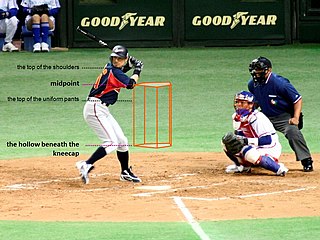 W
WIn baseball, the strike zone is the volume of space through which a pitch must pass in order to be called a strike even if the batter does not swing. The strike zone is defined as the volume of space above home plate and between the batter's knees and the midpoint of their torso. Whether a pitch passes through the zone is decided by an umpire, who is generally positioned behind the catcher.
 W
WIn baseball or softball, a strikeout occurs when a batter racks up three strikes during a time at bat. It usually means the batter is out. A strikeout is a statistic recorded for both pitchers and batters, and is denoted by K. A "strikeout looking" — in which the batter does not swing and the third strike is called by the umpire — is usually denoted by a ꓘ.
 W
WIn baseball, a strikeout occurs when a pitcher throws three strikes to a batter during his time at bat. Twenty different pitchers have struck out at least 18 batters in a single nine-inning Major League Baseball (MLB) game as of 2016, the most recent being Max Scherzer of the Washington Nationals on May 11, 2016. Four players have accomplished the feat more than once in their career; no player has ever struck out more than 20 batters in a nine-inning game. Charlie Sweeney was the first player to strike out 18 batters in a single game, doing so for the Providence Grays against the Boston Beaneaters on June 7, 1884. In spite of this, Bob Feller is viewed as the first pitcher to accomplish the feat, since his then-record 18 strikeouts was the first to occur during the 20th century and the live-ball era.
 W
WIn baseball, the strikeout is a statistic used to evaluate pitchers. A pitcher earns a strikeout when he puts out the batter he is facing by throwing a ball through the strike zone, "defined as that area over homeplate (sic) the upper limit of which is a horizontal line at the midpoint between the top of the shoulders and the top of the uniform pants, and the lower level is a line at the hollow beneath the kneecap", which is not put in play. Strikeouts are awarded in four situations: if the batter is put out on a third strike caught by the catcher ; if the pitcher throws a third strike which is not caught with fewer than two outs; if the batter becomes a baserunner on an uncaught third strike; or if the batter bunts the ball into foul territory with two strikes.
 W
WIn baseball, a strikeout occurs when a pitcher throws three strikes to a batter during his time at bat. An immaculate inning occurs when a pitcher strikes out all three batters he faces in one inning, using the minimum possible number of pitches (nine). Ninety-four different pitchers have struck out three batters on nine consecutive pitches in a half-inning of a Major League Baseball (MLB) game as of October 2020, the most recent being Zach Plesac of the Cleveland Indians on September 18, 2020. Seven have accomplished the feat more than once in their career, and no player has ever struck out four batters on twelve pitches in an inning. John Clarkson was the first player to strike out three batters on nine pitches, doing so in the third inning for the Boston Beaneaters against the Philadelphia Quakers on June 4, 1889.
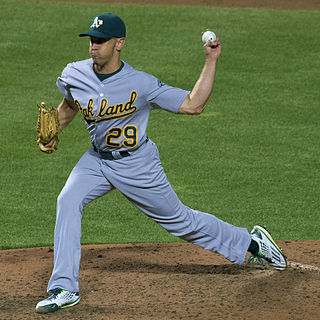 W
WIn baseball, a switch-pitcher is an ambidextrous pitcher who is able to pitch with both the right and left hand from the pitcher's mound.
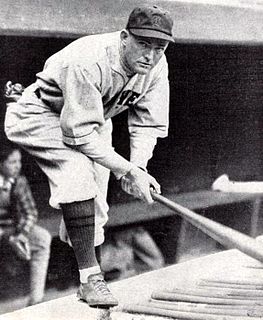 W
WIn baseball, a player earns a Triple Crown when he leads a league in three specific statistical categories in the same season. The term "Triple Crown" generally refers to the batting achievement of leading a league in batting average, home runs, and runs batted in (RBI) over the same season. The term "Pitching Triple Crown" refers to the pitching achievement of leading a league in wins, strikeouts, and earned run average (ERA).